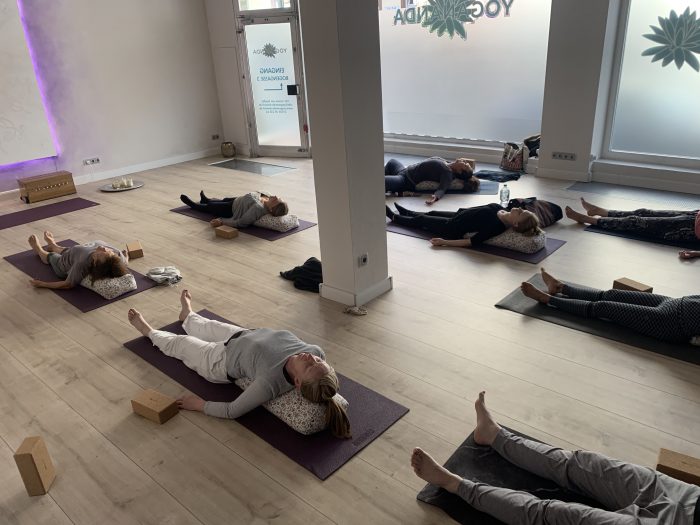Anxiety, insomnia, irritability, and lack of patience are some of our worst enemies these days.
Our society has never moved at a faster pace than we are now. The infinite stream of information we are facing on social media is firing us up all day long. With important topics, not so important ones, and a lot in between, sometimes it can be hard to separate one from the other.
Our nervous system is not made for that, or better said, it is not prepared to deal with it.
As human beings, we basically have two different operational modes: “fight-or-flight” and “rest and digest.” The fight-or-flight mode is what we are in most of the time—we are ready to react to something. Our ancestors had to be on alert when there was something rattling in the bushes, because it could have been a tiger. Their reaction usually resulted in a higher pulse rate and the preparation to run. We don’t have to learn how to react to a different situation; evolution has given us that ability as an instinct.
In our modern civilization, there is a pretty low risk of getting attacked by a wild animal, but there are still many dangers waiting for us. It could be an email from our boss, a phone call from a friend, or just a post of our high school enemy getting married. For our nervous system, those things can be just as threatening as a tiger was to our ancestors.
How do we deal with that?
First of all, we need to learn to recognize when situations require a direct reaction from us and when we can give them some time to settle. We don’t have to reply straight away to every message we receive on social media. It is fine to finish what we were doing before we take a look at it. When someone shares something that irritates us, we can remind ourselves that others having a good time does not take away anything from us. If somebody makes a statement that enrages us, we still have to remember that this is usually not a threat to our well-being.
The more time we spend in fight-or-flight mode, the more irritable we become. If every little thing has the potential to drive us nuts, we might feel pretty drained after some time. Being constantly stressed has the potential to make us see dangers where there are none, and it becomes hard to differentiate one from the other. What is the way out of this?
It is to enter rest and digest mode, which relies on our vagus nerve, parasympathetic nervous system, or more simply “our ability to relax.”
Unfortunately, this is something that evolution has not taught us. It was not necessary to be able to relax for our survival, but nowadays it is needed to ensure our well-being. That is why we need to learn how to cultivate our ability to rest. Otherwise, we’ll literally go crazy over time.
Finding relaxation offers our body the chance to restore itself. Our muscles relax, our breath deepens, and our mind takes a break. All of this allows our body and mind to recharge—it is like plugging in our phones to fill up the battery.
When we are not used to slowing down, this might feel uncomfortable. Once we come to stillness, our mind takes over and tells us our story. The more stressed we are, the louder that inner voice is shouting at us, making it impossible to rest.
We need to do this; we need to do that. We worry about this, and we get angry about that. There is always something going on in our mind, unless we practice to give it a break.
This can be done with mediation. But one difficulty with meditation is that we need to find a comfortable position to sit, which can be difficult for many of us. Tight hips are not helpful when we are trying to sit in Lotus position. Therefore, I found a way of introducing relaxation and meditation into my personal practice.
It is like a gateway drug toward meditation: Restorative Yoga.
Restorative Yoga, for those who haven’t heard of it, is a practice where we use bolsters, blankets, pillows, straps, and blocks to support our bodies in various different shapes. By staying in these shapes for longer periods of time, we can focus on our breath and activate our parasympathetic nervous system.
Unlike a Vinyasa class, there is no physical challenge that distracts us from our mind. All that is moving our bodies is breath. Spending 90 minutes with our breath and thoughts can be overwhelming as we get started—that’s why it is a practice and not just being lazy and resting on pillows. Coming to stillness can be the bravest thing we’ve done in a long time. It means that we are facing ourselves with no distraction.
With this practice, we eventually find peace within and cultivate our ability to relax at any time we choose. Once we see the power of silence and taking a deep breath when necessary, we become less reactive to anything happening around us. We learn to slow down.
Most of us don’t need to learn how to try harder, but we do need to accept what is and go from there.
Even those of us who have been practicing yoga for years, but still suffer from anxiety and restlessness, can benefit from Restorative Yoga. It helped my personal practice a lot and I highly recommend giving it a try.
Do a little test on yourself: switch off your phone, put your legs up on a pillow, and close your eyes. Try observing your breath, body, and mind for 10 minutes and see how you feel.
If you feel yourself getting nervous, fighting the urge to get out of the pose, or feeling so relaxed that you fall asleep, you might want to try Restorative Yoga. Your nervous system needs it!
~









Read 27 comments and reply